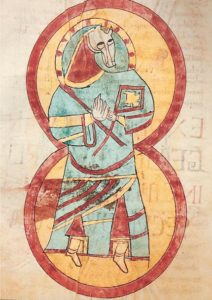La Légende dorée ~ The Golden Legend …
Sur le site EBAY, un exemplaire de la Légende dorée …
Voragine, Jacobus de. Dat Duytsche Passionail. Dat eyrste deil [The Golden Legend] [Legenda Aurea]. Cologne: Ludwig von Renchen, 1485.


Part One (of two parts). Folio (285 x 215 mm.). Ff. 252 (lacking ff. 71, 78, 79, 125 and last blank). Gothic letter, double column, three large woodcut initials, initial spaces with guide letters completed with green and red painted initials, large woodcut border on ff. II, in four pieces, of vines with flowers, fruit, birds and man to lower outer corner, 97 woodcuts with repeats, illustrating each legend, one half page woodcut, all in strictly CONTEMPORARY HAND COLOURING, (yellows, browns, green and reds), a line of blind printing to lower half of title page.
Contemporary marginalia by each woodcut, large painted armorial device on title page, (depicted hanging from a nail) with motto “Verstaet, Eerghy, Oordeeld” in a scroll above with initials HH to sides and monogram at centre (as yet unidentified).
Title page, ff. II and last ll. a little dusty and a little chipped at fore-edge, paper label removed from verso of title-page with traces of old repair at inner margin recto and on verso of last ll., lower outer corner of these three leaves also with ancient restoration, occasional thumbs marks and minor soiling to margins, a few small marginal tears with ancient repairs not touching text.
A rare copy of one of the few illustrated incunable editions of Jacobus de Voragine’s Legenda Aurea, or Golden Legend – not be confused with Der Heiligen Leben, or other legendaries of the period. An excellent example, with superb contemporary hand colouring of the woodcuts, in an unusual Low German translation. The printer, Ludwig von Renchen, published a Latin edition simultaneously, without the woodcuts (BMC I 267); he clearly designed this illustrated edition to reach a much wider audience.
A tradition emerged at an early stage in Germany of dividing Legendariesin to two parts: sometimes referred to as \ »Winterteil\ » and \ »Sommerteil\ », or \ »Winter\ » and \ »Summer\ » parts. This tradition continued into the printed era, and the two parts of incunable German Legendaries were often printed up to a year apart.
Renchen applied this tradition (in addition to the traditions of illustration and use of the vernacular found in other German incunable legendaries) to his edition of The Golden Legend of 1485: Part One was published on 21 July; Part Two on 31 October. The two parts of German incunable legendaries are now almost invariably encountered separately (see our summary of auction records below).
The Golden Legend by Jacobus de Voragine is a collection of fanciful hagiographies, lives of the saints, that became a late medieval bestseller. It was probably compiled around 1260, initially titled simply Legenda Sanctorum, or \ »Saints’ readings\ ». More than a thousand manuscript copies of the work survive, and printed editions appeared quickly, not only in Latin, but also in every major European language. It was one of the first books William Caxton printed in English translation; his version appeared in 1483. It remains a treasure-house of European culture, crammed full of the things which everyone, once upon a time, used to know, and is the closest thing we have to an encyclopedia of the lore of the saints in the late Middle Ages. As such it is invaluable to art historians and medievalists who seek to identify saints depicted in art by their deeds and attributes.
The textual history of the Golden Legend in Germany is complex. In the medieval period, elements of the Golden Legend were incorporated into a number of other works, most famously the Vers-Passional, completed between 1290-1300, and Der Heiligen Leben, complete between 1396-1410. Der Heiligen Leben was composed by a Dominican friar from Nuremburg, and contains 251 legends from multiple sources including the Vers-Passional, the Martyrbuch, The Golden Legend, the Speculum Historiale of Vincent of Beauvais, and the Latin Vitae Patrum – only 31 of the lives recorded are drawn from the Golden Legend (see Jeep, p. 445). As a work that often appeared in the vernacular, and that was aimed at a wide audience, editions of Der Heiligen Leben had a strong tradition of illustration, in contrast to The Golden Legend. At least 14 of the 23 incunable editions of Der Heiligen Leben were illustrated with woodcuts. In contrast, only about 20 of the 152 incunable editions of The Golden Legend were illustrated with woodcuts – most of these being French and German vernacular editions.
For reasons of tradition and convenience, bibliographies (most notably the ISTC), auction records and libraries often catalogue Der Heiligen Leben as authored by Voragine – concealing the fact that The Golden Legend and Der Heiligen Leben are in fact entirely separate works.
It should be noted that the present copy of Renchen’s 1485 Low German Duytsche Passionail is not Der Heiligen Leben – it is a translation of Voragine’s Golden Legend (see Kalinke, p. 7). We have been unable to establish which stemma of the Golden Legend Renchen used (and whether he relied on printed or manuscript sources), but his edition includes 159 of the 180 Lives or legends included in the critical edition prepared by Graesse in 1845 (the only modern critical edition in Latin), the vast majority in precisely the same ordering. Interestingly, Renchen includes an appendix after the main body of the text with a number of additional legends of local and north European interest (in common with Caxton, who also included additional lives of English interest in his translation).

The woodcuts in this edition emphasize line and pattern over three-dimensional form; there is no cross hatching or attempt at perspective and as such they represent a much earlier style of illustration derived from the first professional wood-engravers who were originally card-makers. (Wood-engravers were generally called card-painters – Briefmalers – in Germany, from about the middle of the fifteenth century).
The painting in this copy has remained remarkably fresh and vibrant (exposed to sunlight the fragile pigments often fade and discolour). Coloured copies are significantly rarer than ordinary copies. As popular and very well used works, they were often read to oblivion or mutilated in the religious wars of the next five centuries, and are rarely complete or in good condition. Of the 26 copies in ISTC 16 are imperfect. A lovely example of this wonderful piece of late medieval popular art.
Hand-coloured, illustrated incunable Golden Legends are rare on the market – and are usually found incomplete. Of uncoloured, illustrated incunable Golden Legends, APBC lists 4 copies, 3 of these incomplete.
Of hand-coloured, illustrated incunable copies of Der Heiligen Leben, (see above for the relationship between the Golden Legend and Der Heiligen Leben), ABPC lists 8 copies sold at auction worldwide since 1975 (one of these copies selling 3 times). All of these copies are Sommerteil or Winterteil only (6 copies of Sommerteil, 2 copies of Winterteil). The most recent hand-coloured and illustrated incunable copies of Der Heiligen Leben sold at auction on 24/10/07 (Bloomsbury Auctions New York, lot 13: Urach, 1481, Sommerteil only, lacking one leaf, $96,000), and on 28/10/2005 (Pierre Berge Auctions, lot 5: Augsburg, 1471, Winterteil only, Euros €210,000).
SOURCE : Nicholas Marlowe Rare Books
http://stores.ebay.fr/Nicholas-Marlowe-Rare-Books
Leave a comment
PAGES ANNEXES
Auteur du blog : Jean-Luc DEUFFIC




